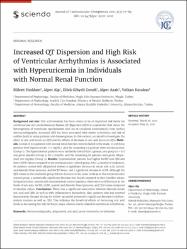Increased QT Dispersion and High Risk of Ventricular Arrhythmias is Associated with Hyperuricemia in Individuals with Normal Renal Function
Künye
Huddam, Bülent, Alp, Alper, Genek, Dilek Gibyeli, Azak, Alper and Karakus, Volkan. "Increased QT Dispersion and High Risk of Ventricular Arrhythmias is Associated with Hyperuricemia in Individuals with Normal Renal Function" Journal Of Cardiovascular Emergencies, vol.7, no.3, 2021, pp.77-83. https://doi.org/10.2478/jce-2021-0011Özet
Background and aim: Uric acid elevation has been shown to be an important risk factor for cardiovascular and cerebrobascular disease. QT dispersion (QTd) is a parameter that shows the heterogeneity of ventricular repolarization and can be calculated noninvasively from surface electrocardiography. Increased QTd has been associated with severe arrhythmia and risk of sudden death in many patients and disease groups. In this context, we aimed to investigate the effect of uric acid levels on QTd and the effects of decrease in uric acid levels on QTd. Metb-ods: A total of 225 patients with normal renal function were included in the study; 133 of these patients were hyperuricemic (>7 mg/dL), and the remaining 72 patients were normouricemic (Group 1). The hyperuricemic patients were randomly divided into 2 groups, one group (n = 67) was given placebo (Group 2) for 4 months, and the remaining 66 patients were given allopu- rinol 300 mg/day (Group 3). Results: Hyperuricemic patients had higher hsCRP and QTd and lower eGFR values compared to the normouricemic control group. After 4 months of treatment, 66 patients treated with allopurinol showed a significant decrease in serum uric acid, systolic and diastolic blood pressure, and hsCRP levels, and a significant increase in eGFR. Although the QTd values in the treatment group did not decrease to the same levels as in the normouricemic control group, a statistically significant decrease was found compared to their baseline values. In hyperuricemic control and normouricemic control patients, there were no differences in the levels of uric acid, hsCRP, eGFR, systolic and diastolic blood pressure, and QTd values compared to baseline values. Conclusions: There was a significant association between elevated serum uric acid and QTd, as well as with inflammatory biomarkers. Also, patients who had received hypouricemic therapy during the follow-up period presented a significant decrease in inflam- matory markers as well as QTd. This indicates the beneficial effects of decreasing uric acid levels in decreasing the risk for future major adverse events related to ventricular arrhythmias.


















